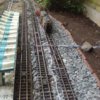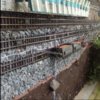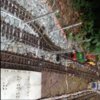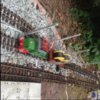James Day
Guano Corner Rly - Runs weekly - Guano permitting
After making lots of temporary layouts with catenary that worked, I realised the other day that I had created two branches on my now 3 year old layout with catenary that didn't. Something had to be done!
I have always exploited the extra movement that catenary can bring, allowing two trains to run under independent control on the same track. I know DCC allows that, but my thing is automation and whilst I am sure automation can be done with DCC, I have no idea how to do it, or how much it would cost, nor the will to do it, wheras with a few magnets, reeds and EPL drives I can achieve a lot of movement and interaction very quickly and cheaply.
I still had a module I made 24 years ago that contained 4 EPL drives and allowed two trams to shuttle up and down a single line, passing each other in a sprung bladed loop. One tram was track powered the other catenary powered. The box had be unused for some years but that was going to be the basis for my new project.
I have a branch 67' long equipped throughout with unpowered LGB catenary. I can run trains up and down this with a shuttle module, and they can swap over at one end. I decided to power the catenary on the branch up, but my real goal is to get the twin trams operating automatically again, although that will mean adding a loop..
I no longer use EPL drives to reverse, it is horribly clumsy. A chum has built some beautiful shuttle modules for me that incorporate a variable dwell and the option to change over trains at each end. My plan was to have one module for the catenary tram, and a second for the track powered one.
So the first job was to test if two new reversing modules would operate reliably on a common return track. I set up a temporary shuttle next to one of the branches and bonded the two to form common return. The trains ran up and down on each without any issues. I could have modern smooth reversing on track and catenary with a built in dwell!
Next the 'four EPL' tram control box was dug out and everything to do with reversing was removed. This left me with two EPL drives, around half the wiring and a few switches. This was then tested and then removed from the now hopelessly big box for placing in a smaller box.
The two remaining EPLs are to be operated by the trams shuttling up and down. Each EPL relates to one track in the central passing loop. This loop has sprung points, so the trams always negotiate it the same way. As the trams arrive they switch the power to their track on and as they leave they switch it off. What stops them crashing is that the power to the isolated sections of the loop is interlocked through both EPL drives - both sections must be 'on' before either tram can leave!
The next day or two were spent installing an extra transformer and the cabling to power the catenary. It will be ready to test tomorrow. I look forward to having proper working catenary very soon!
All that remains to do then is install the loop with the sprung point blades to allow the trams to pass, wire up the revised tram control box and then I can have automated twin tram operation again for the first time in eight years!
More to follow in the next week or so.
James
I have always exploited the extra movement that catenary can bring, allowing two trains to run under independent control on the same track. I know DCC allows that, but my thing is automation and whilst I am sure automation can be done with DCC, I have no idea how to do it, or how much it would cost, nor the will to do it, wheras with a few magnets, reeds and EPL drives I can achieve a lot of movement and interaction very quickly and cheaply.
I still had a module I made 24 years ago that contained 4 EPL drives and allowed two trams to shuttle up and down a single line, passing each other in a sprung bladed loop. One tram was track powered the other catenary powered. The box had be unused for some years but that was going to be the basis for my new project.
I have a branch 67' long equipped throughout with unpowered LGB catenary. I can run trains up and down this with a shuttle module, and they can swap over at one end. I decided to power the catenary on the branch up, but my real goal is to get the twin trams operating automatically again, although that will mean adding a loop..
I no longer use EPL drives to reverse, it is horribly clumsy. A chum has built some beautiful shuttle modules for me that incorporate a variable dwell and the option to change over trains at each end. My plan was to have one module for the catenary tram, and a second for the track powered one.
So the first job was to test if two new reversing modules would operate reliably on a common return track. I set up a temporary shuttle next to one of the branches and bonded the two to form common return. The trains ran up and down on each without any issues. I could have modern smooth reversing on track and catenary with a built in dwell!
Next the 'four EPL' tram control box was dug out and everything to do with reversing was removed. This left me with two EPL drives, around half the wiring and a few switches. This was then tested and then removed from the now hopelessly big box for placing in a smaller box.
The two remaining EPLs are to be operated by the trams shuttling up and down. Each EPL relates to one track in the central passing loop. This loop has sprung points, so the trams always negotiate it the same way. As the trams arrive they switch the power to their track on and as they leave they switch it off. What stops them crashing is that the power to the isolated sections of the loop is interlocked through both EPL drives - both sections must be 'on' before either tram can leave!
The next day or two were spent installing an extra transformer and the cabling to power the catenary. It will be ready to test tomorrow. I look forward to having proper working catenary very soon!
All that remains to do then is install the loop with the sprung point blades to allow the trams to pass, wire up the revised tram control box and then I can have automated twin tram operation again for the first time in eight years!
More to follow in the next week or so.
James

![IMG_0647[1].jpg IMG_0647[1].jpg](https://cdn.gscalecentral.net/2015/06/63053_2cb1964f779730e1f527ddbea408b17e_thumb.jpg)
![IMG_0648[1].jpg IMG_0648[1].jpg](https://cdn.gscalecentral.net/2015/06/63054_459426d2c40cfabb58c9fb19c97224f6_thumb.jpg)
![IMG_0653[1].jpg IMG_0653[1].jpg](https://cdn.gscalecentral.net/2015/06/63055_044f1bc6be6bdd4aeec6b936782a3316_thumb.jpg)
![IMG_0655[1].jpg IMG_0655[1].jpg](https://cdn.gscalecentral.net/2015/06/63059_8ebdb69aa7796931d275216e99918e2e_thumb.jpg)
![IMG_0657[1].jpg IMG_0657[1].jpg](https://cdn.gscalecentral.net/2015/06/63128_df6d4a7728e4a81cdcfdd6d6b6893a6c_thumb.jpg)
![IMG_0659[1].jpg IMG_0659[1].jpg](https://cdn.gscalecentral.net/2015/06/63129_5264f96c60b303cede2c612b9005f3d2_thumb.jpg)
![IMG_0680[1].jpg IMG_0680[1].jpg](https://cdn.gscalecentral.net/2015/06/63173_e1865fd26b985c94fb3e0a7fe53d1d7d_thumb.jpg)





